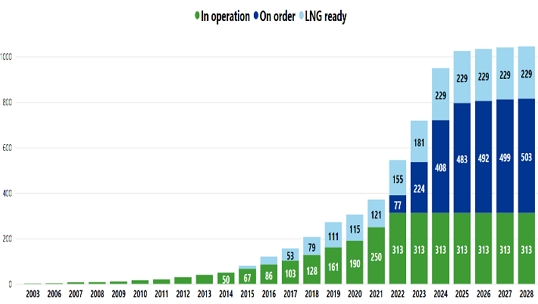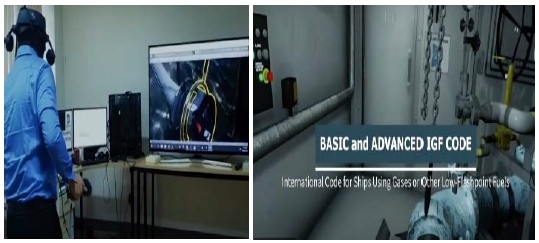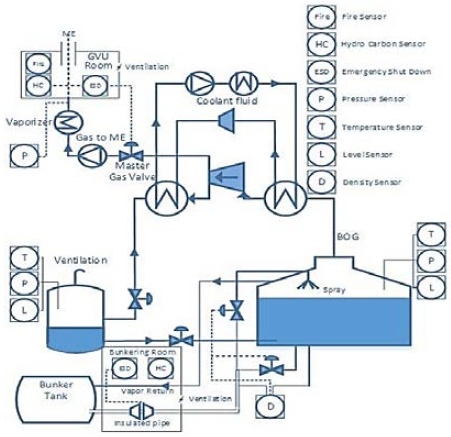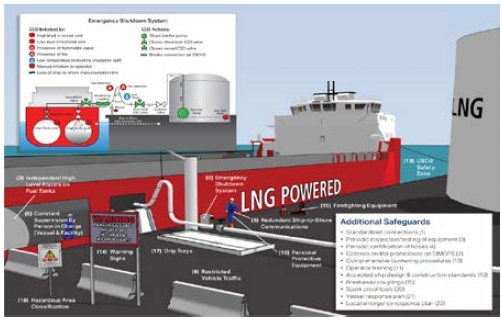
A study on training improvement plan of maritime universities under the International Code of Safety for Ships using Gases or Other Low-flashpoint Fuels (IGF) in Korea
Copyright © The Korean Society of Marine Engineering
This is an Open Access article distributed under the terms of the Creative Commons Attribution Non-Commercial License (http://creativecommons.org/licenses/by-nc/3.0), which permits unrestricted non-commercial use, distribution, and reproduction in any medium, provided the original work is properly cited.
Abstract
As the mandatory code for ships using gases or other low-flashpoint fuels came into force on January 1, 2017, the new training requirements for seafarers working on such ships have become a challenge for Maritime Universities. This study aimed to promptly support the seafarers’ training system in compliance with the Standards of Training, Certification and Watchkeeping (STCW) amendment. The methodology of this study is outlined in the following three major steps: first, the analysis of the relationship between international convention and domestic law concerning the International Code of Safety for Ships Using Gases or Other Low-flashpoint Fuels (IGF) Code; Second, the identification of the minimum requirement of education for seafarers on ships subject to the IGF Code; and Third, practical recommendations for updating the existing training system. In particular, the study suggests that critically pressing is the need for (ⅰ)simulator training for eco-friendly ships; (ⅱ) the construction of training ships applying the IGF code for Maritime Universities, and (ⅲ) collaboration with shipbuilding yards in providing cadet officers and engineers with training opportunities in bunkering. The overall objective is to contribute to the practical training system needs of Maritime Universities in response to the rapidly changing regulatory environment.
Keywords:
IGF Code, STCW, Training system, Maritime universities, Eco-friendly ships1. Introduction
The shipping industry is under increasing pressure to act on the Paris Agreement and reduce greenhouse gas(GHG) emissions into the oceanic atmosphere by introducing new propulsion technologies.*(IMO, 2018) With the International Maritime Organization(IMO) establishing the Energy Efficiency Existing Ship Index(EEXI) minimum technical requirements for supporting the reduction of CO2 emissions by ships, it is imperative of not only newly-built ships but also existing ships of 400 GT and above to calculate the EEXI and attain the International Energy Efficiency Certificate(IEEC), the technical file approved by the Recognized Organization(RO), by December 31st, 2022.† In other words, under the EEXI framework, non-compliant ships will need to take additional measures such as switching to a fuel with low carbon or submitting to other verifiable options, e.g. satisfying the requirements to maintain navigation.
In this regard, the introduction of low-carbon fuels such as LNG, is a key challenge for the worldwide decarbonization, and particularly for the shipping sector. As Figure 1 indicates, the introduction of LNG-fueled ships is expected to grow sharply to approximately 1,000 orders by 2028.
To minimize the risk of the fuels and provide mandatory international standards for ships other than those covered by the International Code for the Construction and Equipment of Ships Carrying Liquefied Gases in Bulk(IGC Code), the IMO has adopted the Code of Safety Using Gases or other Low-Flashpoint Fuels(IGF Code). The IGF code is for mandatory regulations on facilities and safety for ships propelled by a low flashpoint fuel (IMO, 2014a). In addition, the IMO amended the International Convention on Standards of Training, Certification, and Watchkeeping for Seafarers, 1978(STCW) to include regulations regarding training required for seafarers on ships applying to the IGF Code.
The need for updating the courses and training of future seafarers is crucial for satisfying their ability to operate eco-friendly ships. By contrast, Maritime Universities have faced difficulties in implementing the IGF Code because of the lack of training facilities such as bunkering operation simulators and LNG-fueled training ships.
However, few studies have been conducted to raise the awareness of Korean seafarers of the need to comply with the requirements of the IGF Code (Han et al., 2015; Han et al., 2016). To promptly support the seafarers’ training system in Maritime Universities, this study aimed to analyze the relationship between international convention and domestic law subject to the IGF Code, identifying the minimum requirement of training for all levels of seafarers on ships subject to the IGF Code, and making practical recommendations for updating the existing training system.
2. Relevant laws and regulations regarding the IGF code
Before we examine the critical factors for developing the training curriculum, an understanding of current regulations concerning the IGF Code is a requisite.
This chapter explores the regulations from two perspectives, international and domestic, and compares the required mandatory educational standard with the status quo of educational training.
2.1 International Convention
At the 72nd MEPC meeting, the IMO established short-term reduction goals for 2030 and medium-to long-term reduction goals for 2050 to achieve the overall goal of GHG reduction. At the 76th MEPC meeting, measures were prepared to elaborate the technical and operational procedures to be taken to reduce GHG emissions, in line with the agreement in the previous meeting (KMC, 2021).
Interim guidance on training for seafarers on ships using gases or other low-flashpoint fuels aims to standardize the training and certification of seafarers who will work on ships running on such fuels(IMO, 2014b). Finally, the IGF Code was adopted and entered into force on January 1, 2017(IMO, 2015a). To comply with the requirements of the IGF code, some amendments were made to Chapters II-1‡ and II-2, and the Appendix of the International Convention for the Safety of Life at Sea(SOLAS), which also entered into force on January 1, 2017.§
Other important amendments were adopted on June 11 2015. The STCW Convention **includes new mandatory minimum requirements for the training and qualifications of masters, officers, ratings, and other seafarers on ships, subject to the IGF Code.†† Specifically, the IMO amended STCW Convention Regulation V ‡‡ in the 95th session of the Maritime Safety Committee(MSC). As presented in Table 1, Sec. A-V/3§§ of the STCW Convention was amended accordingly.
In summary, the IMO categorized seafarers’ training into two types, basic and advanced, to incorporate the requirements for seafarers serving on ships subject to the IGF Code into the STCW Convention. This convention came into force on the same date as other relevant conventions (IMO, 2015b).
Under these frameworks, ship officers who have completed basic and advanced training and obtained certificates required by STCW Section A-V/3, may only board LNG-fueled ships subject to the IGF Code. According to this standard, it is an important requirement that three bunkering operations must be performed, two of which can be replaced by simulator training.
2.2 Domestic Law
The Republic of Korea has introduced STCW into the Ship Officers Act and the Seafarers Act. *** In addition, the Ministry of Oceans and Fisheries implementedthe Act on the Promotion of Development and Distribution of Environmentally Friendly Ships(Eco-Friendly Ship Act), which came into force on January 1, 2020.
Generally, various types of eco-friendly ships are recognized by the Eco-Friendly Ship Act, as illustrated in Table 2. This study limits the discussion to low flash point fuel propulsion ships described in article 2(3)B.
As the IGF Code entered into force in 2017, the ROK amended the Seafarers’ Act and the Ship Officers Act to domestically meet the requirements of the STCW Convention. Specifically, Article 64(6) of the Seafarers’ Act describes the qualification of seafarers subject to the IGF Code, and Article 42(2) of the enforcement ordinance of the act deals with the details.
Meanwhile, according to Article 16 of the Ship Officers Act, marine officers are required to undergo refresher training and implement STCW.††† Regarding requirements for certification, Article 5 of the Act specifies that a person who has undergone education and training required for licensing according to the classes can be granted certification from the Minister of Oceans and Fisheries.‡‡‡ The requirements in Table 3 can be better understood by connecting Article 5 of the Act with Article 2 of the enforcement rule of the Act.

Educational requirement for seafarers subject to the IGF Code(Source: Enforcement Rule of Ship Personnel Act, 2017)
According to the regulations in Table 3, for seafarers to board an IGF code-applied ship for the first time, they should complete basic training or have experience in managing liquefied gas ships. The master and all engineers should complete basic and advanced training, three bunkering operations, and three or more months of boarding experience in IGF code-applied ships. In addition, in order to be issued a seafarer’s certificate, it is necessary to pass the competency examination held by the Korea Institute of Maritime and Fisheries§§§.
2.3 Current educational system in maritime universities
It is important to comply with the minimum requirements of the training under STCW. However, considering the current educational system in Maritime Universities, these institutions are still not ready to respond to this fast-changing environment. Furthermore, Universities have not provided a curriculum for students on the fuel characteristics of ships subject to the IGF Code. Accordingly, a number of shipping companies have difficulty recruiting seafarers who have completed compulsory training courses(MacNet 2022).
The current educational system has three key insufficiencies; (ⅰ) Maritime universities do not have an educational module relevant to the basic structure and characteristics of eco-friendly ships; (ⅱ) owing to the fact that the existing training ships are not subject to the IGF Code, there is no physical environment in the universities for them to conduct their own bunkering practice; and (ⅲ) the universities have not authorized furnished simulators for bunkering operation training.
3. Case studies on the training system
To gain insight into the training system, this study analyzed overseas training institutes’ practices. This paper targets the maritime academy that offers training courses subject to the IGF Code training, which comply with the requirements laid down in the STCW and the IMO Model Course for IGF Code training for ship officers.
This paper introduces the training system of Aboa Mare in Finland as the only training center in the world that offers a 5-day IGF Code Simulator course replacing the necessary sea time (30 days) required for an advanced IGF Code certificate of proficiency(CoP). Furthermore, it introduces the alliance-training system of GigaMare in the Philippines.
3.1 Aboa Mare
Aboa Mare offers an IGF-combined (basic and advanced) course and an IGF Simulator course.
An IGF-combined course provides the safe operation of a ship subject to the IGF code, basics in physical and chemical properties of gas fuel, operating and controlling propulsion plants etc., in a duration of 5 days. This course is a prerequisite for our IGF Simulator course. As the following course, the IGF Code simulator training provides 3 types of courses; LNG Tank simulator, Gas valve unit(GVU) simulator, and Hands-on training with a dual fuel engine simulator.
The Finnish Maritime Authorities(Traficom) approve that the required 30 sea days on board an IGF ship, including three LNG bunkering operations for the Advanced Certificate STCW Regulation V/3 [8.2], can be substituted with a separate IGF simulator course. Accordingly, this 5-day IGF simulator training corresponds to 30 days of seagoing experience required by the STCW. The training includes two of the three bunkering operations required.
3.2 GigaMare
The GigaMare system provides an LNG Bunkering VR simulator to offer training on the safe handling of LNG systems. It is subdivided into various levels. The basic-level course provides education and training to all seafarers responsible for designated safety duties associated with the care, use, and emergency response of ships using fuels within the IGF Code. The advancedlevel course intends to provide advanced training for masters, officers, and all personnel with immediate responsibility for the care and use of fuels and fuel systems on ships subject to the IGF Code.
In line with the required conditions for being awarded a certificate of proficiency of advanced training for the cadet of ships subject to the IGF Code, the Finnish Maritime Authorities approved that in the required one month of seagoing service, which covers at least three LNG bunkering operations on a ship subject to the IGF code or on a ship whose fuel is subject to the IGF code, two of the three refuelings can be carried out on a simulator in accordance with paragraph 2 of the A-V/3 regulation of the STCW.
4. Recommendation for a customized training system on ships subject to the IGF Code
Based on the preceding discussion, a number of specific training courses have been identified**** that will enable seafarers’ educational institutions to officially recognize the need to prepare customized training systems in compliance with the IGF Code.
In this regard, the research suggests that particularly pressing is the need for (ⅰ) simulator training for LNG-fueled ships; (ⅱ) construction of training ships applying the IGF Code for Maritime Universities and (ⅲ) providing cadet officers and engineers with bunkering training opportunities in collaboration with shipbuilding yards.
4.1 Simulator training for LNG-fueled ships
To comply with the STCW amendment, at least two bunkering operations can be replaced with an approved simulator. Given that several seafarers have faced difficulties in obtaining training opportunities on LNG-fueled ships, formulating a simulator training course is important and timely.
In this regard, Zincir and Dere drew an outline of the training simulator reflecting the LNG transfer system and operation procedure required in the LNG bunkering process with five different scenarios, as shown in Table 4. Furthermore, they suggested a sample system drawing of an LNG-fueled ship simulator program for training engineers, as illustrated in Figure 3(Zincir, B et al., 2015). This example can be a good reference for Maritime Universities to introduce a training simulator system.
4.2 Construction of training ships applying the IGF Code
Because there are few ships subject to the IGF Code in the market, it is difficult to meet the advanced training requirements regarding work experience on the ship with IGC code or IGF Code for more than three months. Another alternative method is a one-month boarding practice and three bunkering operations, which are also difficult. Therefore, one of the most preferred approaches is to construct training ships by applying the IGF Code to the arrangements and system design. Given the lifespan of existing training ships, there is a need for new training ships to make them eco-friendly, as per the IGF Code.††††
By directly addressing bunkering activities under the guidance of the faculties on their own training ships, Maritime University students are expected to be able to satisfy the requirements for LNG-fueled ships as part of their regular curriculum, as illustrated in Figure 4. Faculties can provide practical training to cadet officers in the best practice line, and it is possible to customize the practice so that they can control the BOG and drive the power plants and auxiliary equipment.
4.3 Site training in collaboration with shipyards
To understand the overall process of LNG-fueled ships, cadet officers should receive on-the-job training. While entering and leaving the dry dock, cadet operators may be able to learn the initial gassing-up operation and basic knowledge of safety procedures in accordance with legislation. In addition, they can get a chance to understand how stripping operations are conducted on LNG-fueled vessels.
Due to a lack of facilities, it would be a good idea for maritime universities to cooperate with the industry. Maritime universities can develop students’ abilities to use all data available on board related to bunkering, storage, and securing of fuels addressed by the IGF Code. Consequently, this alliance approach would contribute to securing excellent operators for eco-friendly ships.
5. Conclusion and future directions
By analyzing current regulatory issues regarding the IGF Code, this research posits that Maritime Universities are still a long way from raising seafarers qualified for managing eco-friendly ships.
To deal with the lacuna in the training system, the paper has recommended three measures to ensure the availability of qualified seafarers to manage ships subject to the IGF Code: (ⅰ) introducing simulator training for LNG-fueled ships; (ⅱ) construction of training ships applying the IGF Code for Maritime Universities and (ⅲ) providing cadet officers and engineers with bunkering training opportunities in collaboration with shipbuilding yards.
Nonetheless, it must be noted that these measures are constrained by budgetary considerations. In this regard, the measures can fully be operationalized only under the Eco-Friendly Ship Act to support the budget for the construction of a training ship, and a training simulator specialized in the IGF Code has been drawn for this purpose. From an educational point of view, this study contributes to the background legal framework for the IGF Code and directions for improving the training system in Maritime Universities.
Since there is a growing demand for eco-friendly ships, it appears that there will be more demand for different types of ships using low-flashpoint fuel oil, and IMO shall focus, as a subsequent step, on the specific requirements for ships using alternative fuel, for inclusion in the IGF Code.
In this respect, further research is required to introduce training ships that use ethyl or methyl alcohol as fuel. As the legal status of the training ship is non-commercial and governmental, which is not subject to the ISM and ISPS Codes (Choi et al., 2022), further consideration in connection with the comprehensive governance of LNG-fueled training ship safety is needed.
Author Contributions
Conceptualization, S. I. Lee; Methodology, J. K. Kim; Software; Formal Analysis, J. K. Kim; Investigation, S. H. Bang; Resources, J. K. Kim; Data Curation, J. K. Kim; Writing-Original Draft Preparation, J. K. Kim; Writing-Review & Editing, J. K. Kim; Visualization, J. K. Kim; Supervision, S. I. Lee; Project Administration, S. I. Lee; Funding Acquisition, S. I. Lee.
Notes
References
- ABS Bunkering of Liquefied Natural Gas-fueled Marine Vessels in North America, 2015. p.13.
-
J. H. Choi, S. I. Lee, and S. Y. Kim, “Improving the current regulatory issues concerning training ships for maritime institutions: The South Korean case,” The Asian Journal of Shipping and Logistics, vol. 38, no. 3, pp. 125-134, 2022.
[https://doi.org/10.1016/j.ajsl.2022.02.001]

- B. Zincir and C. Dere, “Adaptation of LNG fuel system workout to a simulator for training purposes of engine officers,” International Conference on Engine Room Simulators (ICERS12), pp. 115-122, 2015.
- DNV Alternative Fuels Insight LNG statistics, [Online]. Available: https://afi.dnv.com/Statistics?repId=1, , Accessed August 11, 2022.
- Enforcement Rule of Ship Personnel Act attached at Table 1(Refresher Training)
-
S. H. Han and Y. C. Lee, “A study on the developments of STCW training of seafarers on ships applying in the IGF Code,” Journal of the Korean Society of Marine Engineering, vol. 39, no. 10, pp. 1054-1061, 2015.
[https://doi.org/10.5916/jkosme.2015.39.10.1054]

-
S. -H. Han, Y. -S. Yun, J. -S. Kim, and Y. -C. Lee, “A study on the development of educational programs for LNG bunkering in consideration of the safety system,” Journal of the Korean Society of Marine Environment and Safety, vol. 22, no. 3, pp. 268-277, 2016.
[https://doi.org/10.7837/kosomes.2016.22.3.268]

- International Maritime Organization (IMO) (2014a). [Online]. Available: https://www.imo.org/en/MediaCentre/PressBriefings/Pages/28-CCC1IGF.aspx, .
- International Maritime Organization (IMO) (2014b). Interim Guidance on Training for Seafarers on Ships Using Gases or Other Low-Flashpoint Fuels, November, pp.17–21, 2014.
- International Maritime Organization (IMO) (2015a). Resolution MSC.391(95), International Code of Safety for Ships Using Gases or Other Low-flashpoint Fuels (IGF Code), 2015.
- International Maritime Organization (IMO). (2015b). The International Convention on Standards of Training, Certification and Watchkeeping for Seafarers, Amendments to the International Convention on Standards of Training, Certification, and Watchkeeping for Seafarers, Annex 6, 2015.
- International Maritime Organization (IMO). (2018). Adoption of the initial IMO strategy on reduction of GHG emissions from ships and existing IMO activity related to reducing GHG emissions in the shipping sector. April 13, 2018.
- Korea Center for International Maritime Safety Cooperation(KMC). (2021). Results of Committee. Korea: Sejong.
- MacNet, Maritime Cluster Networking in Korea, Strategic seminar Ⅱ: How to secure and supply excellent operators for eco-friendly ships, pp. 43-59, 2022.
-
R. Petrinović, N. Mandić, and E. Siriščević, “The importance of maritime law in seafarer training pursuant to amendments to the STCW Convention,” Transactions on Maritime Science, vol. 5, no. 1, pp. 53-64, 2016.
[https://doi.org/10.7225/toms.v05.n01.007]

- GigaMare, IGF Code Training. Available: IGF Code Training Improvements - GigaMare, 2022.




